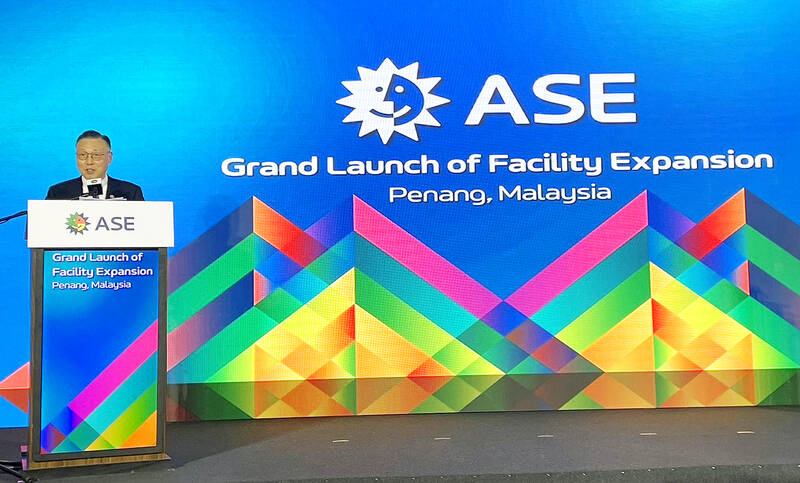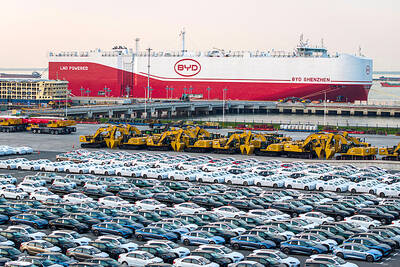ASE Technology Holding Co (日月光投控), the world’s largest provider of outsourced semiconductor assembly and test (OSAT) services, yesterday launched a new advanced manufacturing facility in Penang, Malaysia, aiming to meet growing demand for emerging technologies such as generative artificial intelligence (AI) applications.
The US$300 million facility is a critical step in expanding ASE’s global footprint, offering an alternative for customers from the US, Europe, Japan, South Korea and China to assemble and test chips outside of Taiwan amid efforts to diversify supply chains.
The plant, the company’s fifth in Malaysia, is part of a strategic expansion plan that would more than triple the floor space of ASE Malaysia to approximately 315,870m2, from 92.903m2, it said in a statement.

Photo: CNA
“Southeast Asia is increasingly becoming an important base for semiconductors, given its growing digital economy propelling demand for advanced chips and its shift toward design and chip manufacturing in the past few years,” ASE chief executive officer Tien Wu (吳田玉) said in the statement.
“With Malaysia solidifying its position as a regional semiconductor hub, we see our expanded facility playing an even greater role across the global semiconductor value chain and contributing to the country’s economic growth,” Wu said.
“ASE remains committed to being a driving force for the development of the local and regional semiconductor industry, while continuing to meet and exceed the needs and expectations of our customers,” he said.
A majority of ASE Malaysia’s capacity is used to make image sensors and power management chips for vehicles and industrial devices, while the new plant would build new image sensors for industrial or humanoid robots, the company said.
At home, ASE also plans to make new investments totaling US$200 million to build its first large-size panel-level packaging facility in Kaohsiung, Wu said.
The company is to start a pilot run of the production line in the third quarter this year, he said.
ASE’s capacity expansion at home and overseas is based on its positive demand forecast, it said.
ASE on Monday gave a favorable forecast for its business, riding on the global semiconductor industry’s growth trajectory.
By 2032, total semiconductor revenue is to reach US$1 trillion, with OSAT manufacturers playing a critical role in the global electronics supply chain, Wu said.
Chip packaging and testing service providers are to make up about 20 percent of global semiconductor revenue, an increase from 15 percent over the past decades, he said.
As chips become more advanced and complicated, more materials are required to package them, he said.
For the packaging and testing segment, ASE expects global revenue would surge to US$180 billion in 2029 from US$60 billion in 2019, he said.
Half of the market, or US$90 billion, would be for OSAT in 2029, presenting an enormous opportunity for ASE, which holds 20 to 30 percent of the world’s OSAT market, he added.

Micron Memory Taiwan Co (台灣美光), a subsidiary of US memorychip maker Micron Technology Inc, has been granted a NT$4.7 billion (US$149.5 million) subsidy under the Ministry of Economic Affairs A+ Corporate Innovation and R&D Enhancement program, the ministry said yesterday. The US memorychip maker’s program aims to back the development of high-performance and high-bandwidth memory chips with a total budget of NT$11.75 billion, the ministry said. Aside from the government funding, Micron is to inject the remaining investment of NT$7.06 billion as the company applied to participate the government’s Global Innovation Partnership Program to deepen technology cooperation, a ministry official told the

Taiwan Semiconductor Manufacturing Co (TSMC, 台積電), the world’s leading advanced chipmaker, officially began volume production of its 2-nanometer chips in the fourth quarter of this year, according to a recent update on the company’s Web site. The low-key announcement confirms that TSMC, the go-to chipmaker for artificial intelligence (AI) hardware providers Nvidia Corp and iPhone maker Apple Inc, met its original roadmap for the next-generation technology. Production is currently centered at Fab 22 in Kaohsiung, utilizing the company’s first-generation nanosheet transistor technology. The new architecture achieves “full-node strides in performance and power consumption,” TSMC said. The company described the 2nm process as

POTENTIAL demand: Tesla’s chance of reclaiming its leadership in EVs seems uncertain, but breakthrough in full self-driving could help boost sales, an analyst said Chinese auto giant BYD Co (比亞迪) is poised to surpass Tesla Inc as the world’s biggest electric vehicle (EV) company in annual sales. The two groups are expected to soon publish their final figures for this year, and based on sales data so far this year, there is almost no chance the US company led by CEO Elon Musk would retain its leadership position. As of the end of last month, BYD, which also produces hybrid vehicles, had sold 2.07 million EVs. Tesla, for its part, had sold 1.22 million by the end of September. Tesla’s September figures included a one-time boost in

Shares in Taiwan closed at a new high yesterday, the first trading day of the new year, as contract chipmaker Taiwan Semiconductor Manufacturing Co (TSMC, 台積電) continued to break records amid an artificial intelligence (AI) boom, dealers said. The TAIEX closed up 386.21 points, or 1.33 percent, at 29,349.81, with turnover totaling NT$648.844 billion (US$20.65 billion). “Judging from a stronger Taiwan dollar against the US dollar, I think foreign institutional investors returned from the holidays and brought funds into the local market,” Concord Securities Co (康和證券) analyst Kerry Huang (黃志祺) said. “Foreign investors just rebuilt their positions with TSMC as their top target,